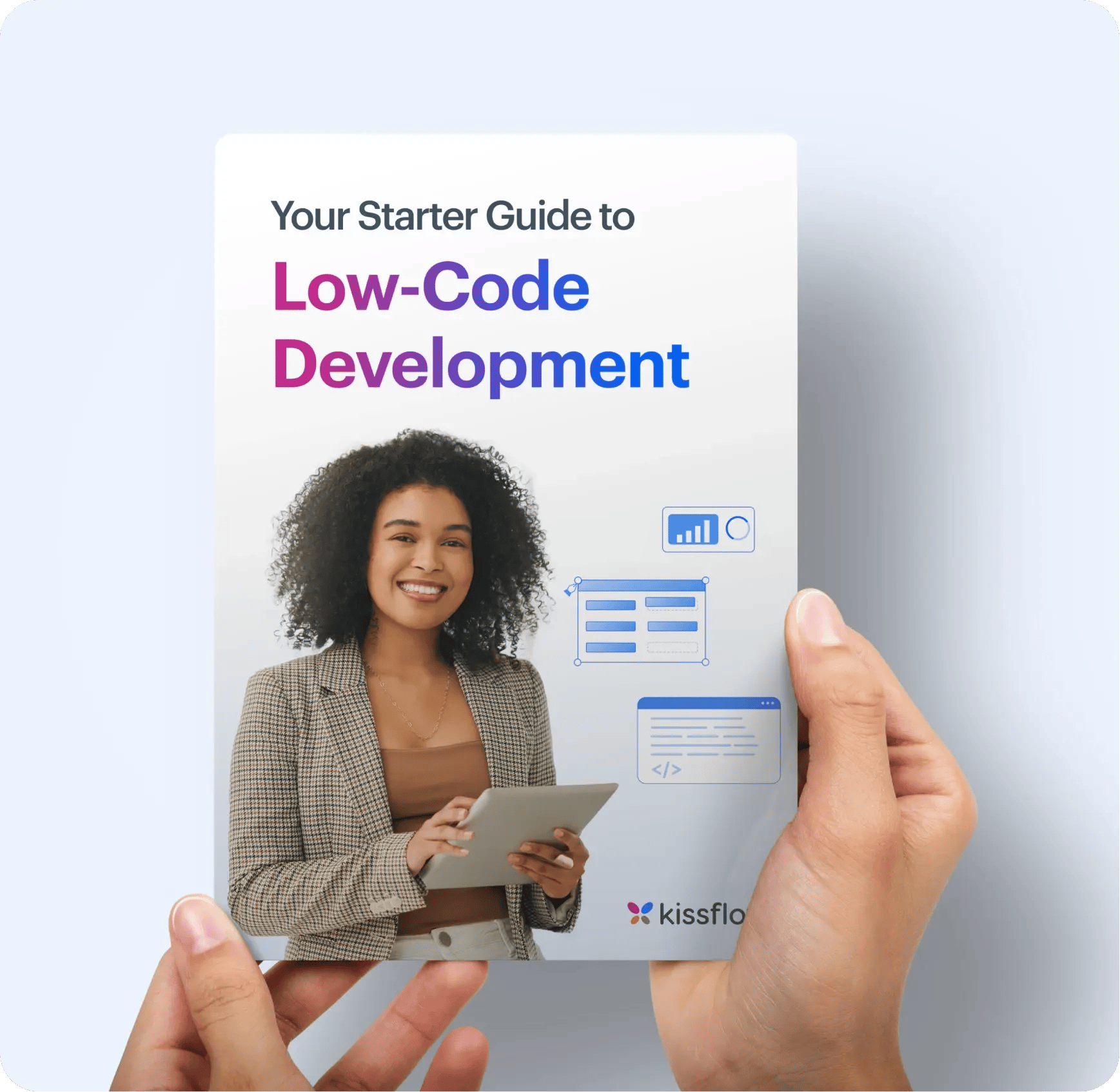
- >
- Low-code Platform>
- Low-Code Platforms for Retail Transformation: Streamlining Omnichannel Operations
Low-Code Platforms for Retail Transformation: Streamlining Omnichannel Operations
Your customer just checked your website for product availability, called your store to confirm stock, tried to reserve it online, then drove to the store only to find out your systems weren't synced. They walked out. And they're not coming back.
Welcome to retail in 2025, where 73 percent of shoppers use multiple channels during their buying journey. And here's the brutal truth: only 8 percent of retailers can consistently deliver real-time omnichannel services.
That gap? That's where you're losing millions in revenue. And your competitors who figured this out? They're eating your lunch.
The omnichannel imperative nobody's prepared for
Let's cut to the chase. The days of "online store" and "physical store" being separate entities are over. Dead. Finished.
Today's customers don't think in channels. They think in experiences. They browse on mobile during their commute. They research on their laptop at work. They buy in-store on weekends. Or they do it in reverse. Or they mix it all up in ways you haven't even thought about yet.
The numbers don't lie. 80 percent of consumers use multiple channels to complete a single purchase. And those omnichannel shoppers? They're worth 30 percent more over their lifetime compared to single-channel customers.
But here's where it gets really interesting. Companies with strong omnichannel engagement strategies retain 89 percent of their customers. Compare that to the pathetic 33 percent retention rate for companies with weak strategies.
The math is simple. Get omnichannel right, and you win. Get it wrong, and you slowly bleed customers to competitors who figured it out.
Why traditional retail IT can't keep up
Here's the problem. Your IT team is already buried. The backlog for new systems stretches into next year. That mobile app integration you requested six months ago? Still in requirements gathering.
Meanwhile, the retail automation market is exploding. From $29.02 billion in 2024 to a projected $71.91 billion by 2034. That's a 9.5 percent annual growth rate, driven by one simple fact: retailers who don't automate are getting crushed.
Traditional development can't move fast enough. Building a custom inventory management system the old way? You're looking at 6-12 months minimum. By the time it launches, your requirements have changed, customer expectations have evolved, and you're already behind again.
This is where low-code platforms enter the picture. And they're not just changing the game. They're rewriting the entire rulebook.
How low-code solves retail's biggest operational nightmares
Think about your typical retail operation for a second. You've got POS systems. Inventory management. Customer loyalty programs. Employee scheduling. Supply chain tracking. Returns processing. Endless reporting requirements. And that's before we even talk about online channels.
Each of these systems probably came from a different vendor. They don't talk to each other. Data lives in silos. And getting a unified view of anything requires someone manually pulling reports from five different places and building a spreadsheet.
Learn more: How digital transformation with low-code empowers enterprises
Sound familiar?
Low-code platforms let you build the connective tissue your retail operation desperately needs. And they let you do it in days or weeks, not months or years.
70 percent of new applications developed by enterprises will use low-code technologies by 2025, according to Gartner. And retail is leading this charge for good reason.
Here's what this actually looks like in practice. Your store manager realizes they need a way to track high-value inventory in real time. With low-code, they work with IT to build that app in a week. It connects to your existing POS and inventory systems. Generates automatic alerts when items move. Creates audit trails. And scales across all your locations.
Try doing that with traditional development. You'd still be in the procurement process.
The buy online, pick up in-store revolution
Let's talk about BOPIS because this is where low-code capabilities really shine. Buy online, pick up in store went from nice-to-have to must-have practically overnight. BOPIS transactions accounted for $95 billion in 2022. By 2025? That number hits $154 billion.
That's a 62 percent increase in three years. And if your systems can't handle BOPIS smoothly, you're leaving money on the table.
But BOPIS isn't just about letting customers check a box during checkout. It's about coordinating inventory visibility across channels in real time. Notifying store staff immediately when online orders come in. Managing pickup windows. Handling substitutions when items are out of stock. Processing returns from online purchases in-store.
Each of these workflows needs custom applications that connect multiple systems. Building them traditionally? Prohibitively expensive. Building them with low-code? Actually feasible.
Real-time inventory: The holy grail that's finally attainable
You know what kills sales faster than almost anything? Showing items as in stock online when they're not. Or worse, telling customers an item is unavailable when it's sitting in your warehouse.
Real-time inventory visibility across all channels isn't just nice to have anymore. It's table stakes. Customers expect it. Your competition is delivering it. And you need to catch up fast.
Low-code platforms let you create inventory synchronization apps that connect your disparate systems without replacing them. Your legacy POS system can talk to your e-commerce platform. Your warehouse management system can update your mobile app in real time. Store associates can see what's available across all locations.
This isn't some far-off vision. Retailers are doing this right now. And they're building these capabilities in weeks, not years.
Customer experience apps your teams can actually build
Here's something that might surprise you. Your best ideas for improving customer experience probably aren't coming from IT. They're coming from the people on the front lines.
Your store managers know what frustrates customers. Your customer service team knows where the process breaks down. Your merchandising team understands what information shoppers need to make decisions.
With low-code platforms, these people can actually build solutions to the problems they see every day. Not submit tickets and wait six months. Build. Deploy. Test. Iterate.
A store associate needs a way to look up customer purchase history instantly? They work with IT to build that app in a few days. The merchandising team wants a tool to manage promotional displays. They create it. Customer service needs a better returns workflow? They design it themselves.
This is the real power of low-code in retail. It's not about replacing your IT team. It's about multiplying their impact by enabling domain experts to solve their own problems with proper oversight.
The integration challenge low-code actually solves
Let's be honest about something. Your retail technology stack is a mess. It's a collection of best-of-breed solutions that were never designed to work together. And every new system you add makes the integration challenge worse.
Traditional integration projects are expensive, time-consuming, and fragile. One vendor updates their API, and suddenly three of your integrations break. You're constantly playing whack-a-mole with connectivity issues.
Low-code platforms provide pre-built connectors for major retail systems. POS systems. E-commerce platforms. Inventory management. CRM. ERP. Payment processors. Loyalty programs. All with visual, drag-and-drop integration tools that don't require deep technical expertise.
More importantly, when something does break, business users can often fix it themselves without waiting for IT intervention. That's the difference between a system being down for hours versus minutes.
Speed to market when every day counts
Here's a scenario. Your competitor just launched a new promotion type that's killing it. You want to match it, but your current systems don't support that workflow. How long until you can respond?
With traditional development, you're looking at months minimum. Requirements gathering. Development. Testing. Approval. Deployment. By the time you launch, the moment has passed and your competitor has moved on to the next thing.
With low-code, that same capability can be built and deployed in days. You can test it in a few stores. Gather feedback. Iterate. And roll it out enterprise-wide within weeks.
In retail, speed matters. Seasonal windows are short. Promotions are time-sensitive. Customer preferences shift quickly. The ability to build and deploy new capabilities fast isn't just a nice advantage. It's existential.
Scale operations without scaling headcount
Let's talk about something every retail CIO is dealing with: doing more with less. Budgets are tight. Hiring is difficult. And the list of technology initiatives keeps growing.
The retail automation market is booming for a reason. Automation reduces labor costs while improving consistency and accuracy. But traditional automation projects require significant development resources and long implementation timelines.
Low-code platforms let you automate processes across your retail operations without massive development teams. Automated inventory reordering. Smart promotion management. Intelligent staffing schedules. Customer communication workflows. Supplier collaboration tools.
Each of these capabilities would traditionally require dedicated development resources. With low-code, business teams build them with IT oversight. You scale your automation efforts without proportionally scaling your technology headcount.
Transform your retail operations at digital speed
The retail landscape is changing faster than ever. Customer expectations keep rising. Competition intensifies daily. And your ability to adapt quickly determines whether you thrive or become irrelevant.
Kissflow's low-code platform is built specifically for enterprise operations like yours. Create custom retail applications that connect your POS systems, inventory management, e-commerce platforms, and customer data in days, not months. Enable store managers, merchandising teams, and operations leaders to build solutions to their own challenges with proper IT governance. From BOPIS workflows to inventory synchronization to customer loyalty programs, deliver the omnichannel experiences your customers demand. All while maintaining security, compliance, and the scalability your retail operation requires.
Stop losing customers to broken omnichannel experiences. See how Kissflow transforms retail operations.
Related Topics:
Visionary CIO Playbook: Lead with Low-Code
Thanks for submitting.
Our solution experts will connect with you to get started.
Related Articles












